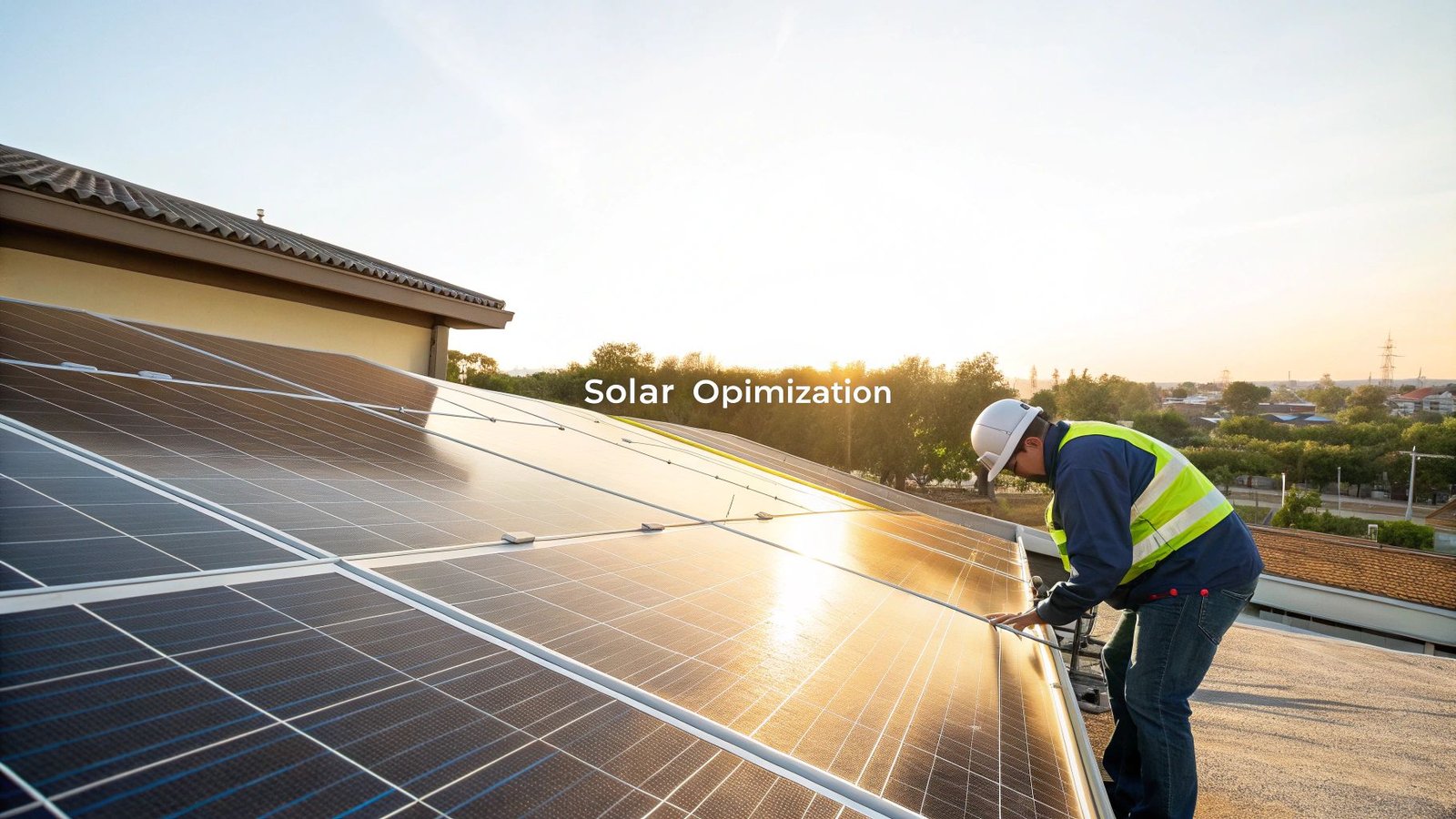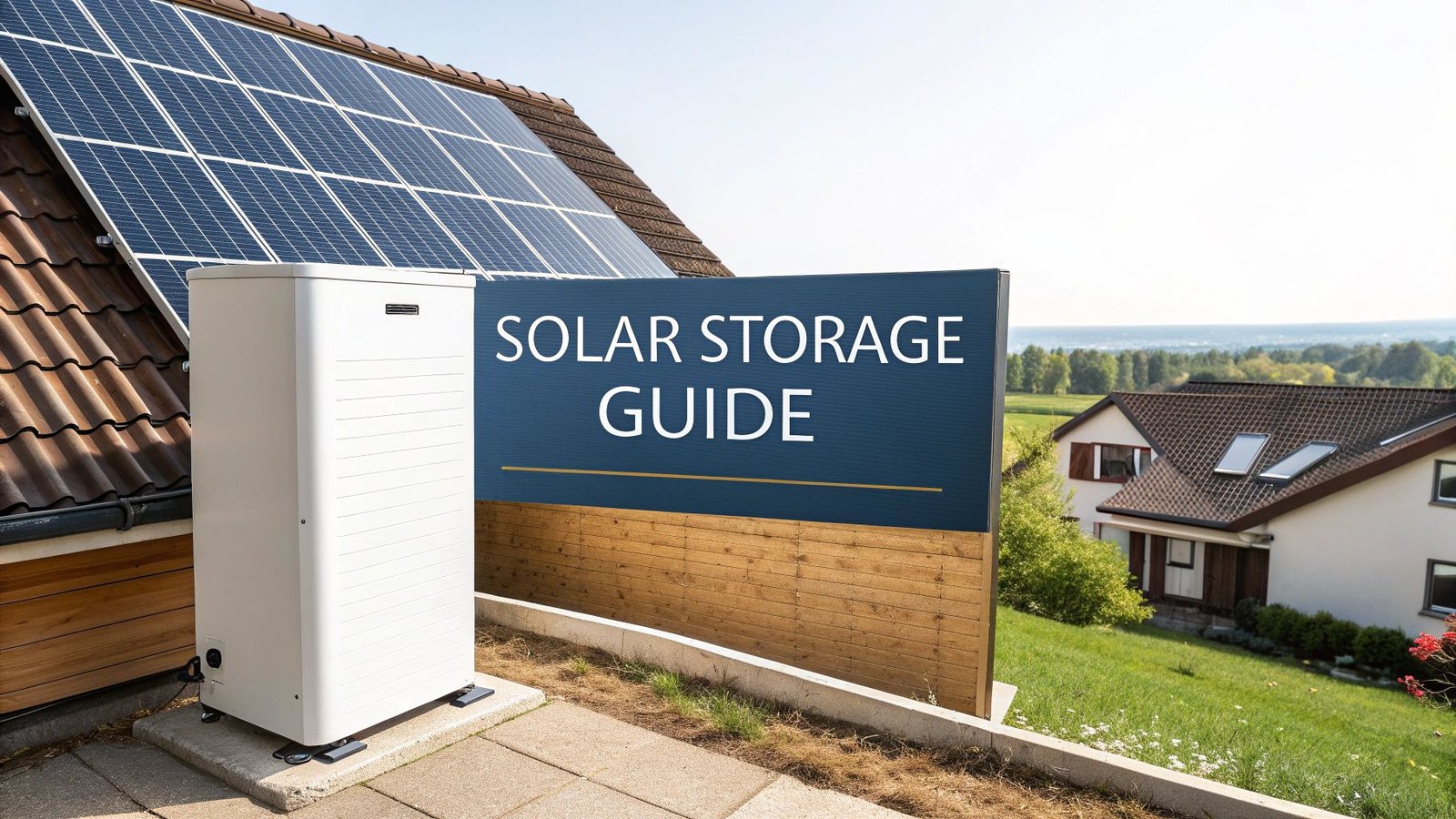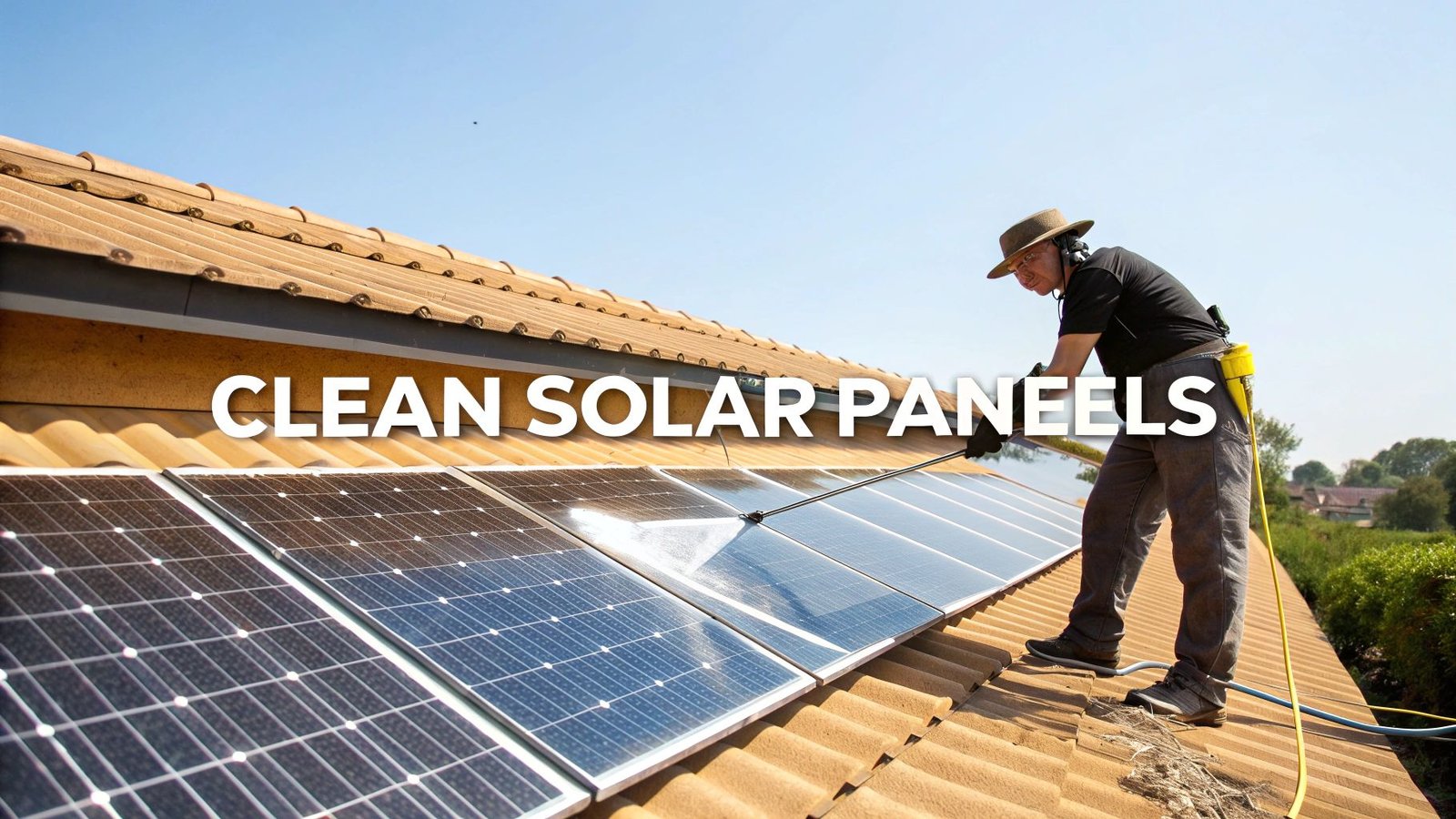La optimización de los paneles solares consiste en gestionar activamente el sistema para aprovechar hasta el último vatio de energía. Se trata de alejarse de la mentalidad de "configúralo y olvídate". En su lugar, nos centramos en aspectos como colocación estratégica de panelesEl eficiencia de sus componentesy mantenimiento continuo para aumentar seriamente tu producción de energía.
Su guía para obtener el máximo rendimiento solar
¿Está sacando realmente el máximo partido a su inversión en energía solar? Es un error común pensar que una vez que los paneles están en el tejado, el trabajo está hecho. La realidad es que la verdadera optimización viene de una serie de estrategias deliberadas diseñadas para capturar cada rayo de luz solar posible. Esta guía le guiará a través de los pasos prácticos que puede dar para mejorar la eficiencia de su sistema, reducir sus facturas de energía y acercarse a la independencia energética real.
Vamos a analizar cómo un posicionamiento preciso, la elección de componentes inteligentes y un poco de cuidado rutinario pueden mejorar drásticamente su potencia. Piense en ello como en la puesta a punto de un motor de alto rendimiento; unos pequeños ajustes pueden conducir a algunas ganancias verdaderamente notables.
Áreas clave de optimización
Alcanzar el máximo rendimiento no es cuestión de una sola bala de plata; es el resultado de varios esfuerzos clave que trabajan juntos. Saber dónde centrar la atención es el primer paso, y el más importante.
Éstas son las principales áreas que cubriremos:
- Emplazamiento estratégico: No basta con orientar los paneles hacia el sur. Un análisis profesional tendrá en cuenta la trayectoria del sol a lo largo del año e identificará las posibles sombras de árboles o edificios cercanos que podrían mermar la producción.
- Selección de componentes: Los inversores y el cableado que elija son tan importantes como los propios paneles. Los componentes de alta eficiencia pueden frenar la pérdida de energía en seco, antes de que llegue a tu casa.
- Mantenimiento rutinario: Esta es una de las grandes. Un sistema limpio y bien mantenido puede producir hasta 20% más potencia que uno descuidado. Un poco de mantenimiento hace mucho.
- Control del rendimiento: El uso de herramientas modernas para controlar el rendimiento de su sistema cambia las reglas del juego. Le permite detectar problemas en el momento en que aparecen y hacer ajustes basados en datos reales, no en conjeturas.
Al centrarse en estas áreas, transformará su instalación solar de una fuente de energía pasiva en un activo altamente optimizado. Esta mentalidad proactiva es fundamental para maximizar la rentabilidad de su inversión en los años venideros.
El camino hacia la independencia energética pasa por el conocimiento y la acción. Cuando más información y nuestro compromiso con la calidad, verá cómo un diseño y una instalación expertos crean la base esencial para un sistema optimizado.
Para que lo tengas más claro, aquí tienes un breve resumen de las estrategias más eficaces y el tipo de mejoras de rendimiento que puedes esperar de cada una de ellas.
Áreas clave de optimización y su impacto en la eficiencia
| Área de optimización | Impacto potencial en la eficiencia | Acción clave |
|---|---|---|
| Colocación y ángulo adecuados | 10-25% | Realizar un análisis de las sombras y fijar la inclinación óptima. |
| Componentes del sistema | 5-15% | Elige microinversores u optimizadores de potencia. |
| Limpieza y mantenimiento | 5-20% | Realice al menos una limpieza anual. |
| Control del rendimiento | 5-10% | Revisar periódicamente los datos para detectar problemas. |
Como puede ver, no se trata de ajustes menores. Cada área ofrece una oportunidad sustancial para aumentar el rendimiento de su sistema y obtener más valor de su inversión.
Encontrar el lugar perfecto para sus paneles
El primer paso, y el más importante, para sacar el máximo partido de los paneles solares se da mucho antes de que los herrajes toquen el tejado. Todo es cuestión de ubicación, ubicación, ubicación. Probablemente hayas oído el viejo consejo de "orientarlos hacia el sur", y aunque es una buena regla general, maximizar realmente la producción de energía es mucho más complicado.
Todo se reduce a un análisis detallado de las sombras. Un buen instalador no se limitará a echar un vistazo a su tejado, sino que determinará exactamente cómo las sombras de los árboles, las chimeneas o la nueva casa de dos plantas de al lado se deslizarán por sus paneles. Estos patrones de sombra no son estáticos: se desplazan a lo largo del día y cambian drásticamente con las estaciones a medida que el sol recorre una trayectoria más alta o más baja por el cielo.
Realización de un análisis de sombras
Seamos prácticos. Supongamos que tienes un hermoso roble maduro en el patio trasero. Es muy atractivo, pero proyecta una larga sombra sobre el lado oeste de su tejado todos los días después de las vacaciones. 3 DE LA TARDE. Un instalador que se salte un análisis adecuado podría colocar los paneles justo en esa zona de sombra, acabando con su producción de energía durante las horas punta de la tarde, cuando su aire acondicionado probablemente esté trabajando más.
Una evaluación profesional del emplazamiento no es negociable. Ayuda al instalador a detectar los obstáculos que acaban con la energía y a diseñar un sistema que los evite de forma inteligente. Esto puede significar agrupar los paneles en el plano oriental del tejado para absorber el sol de la mañana o incluso dividir el conjunto entre dos secciones diferentes del tejado para evitar la sombra del mediodía.
Por eso es tan importante conocer la trayectoria estacional del sol.
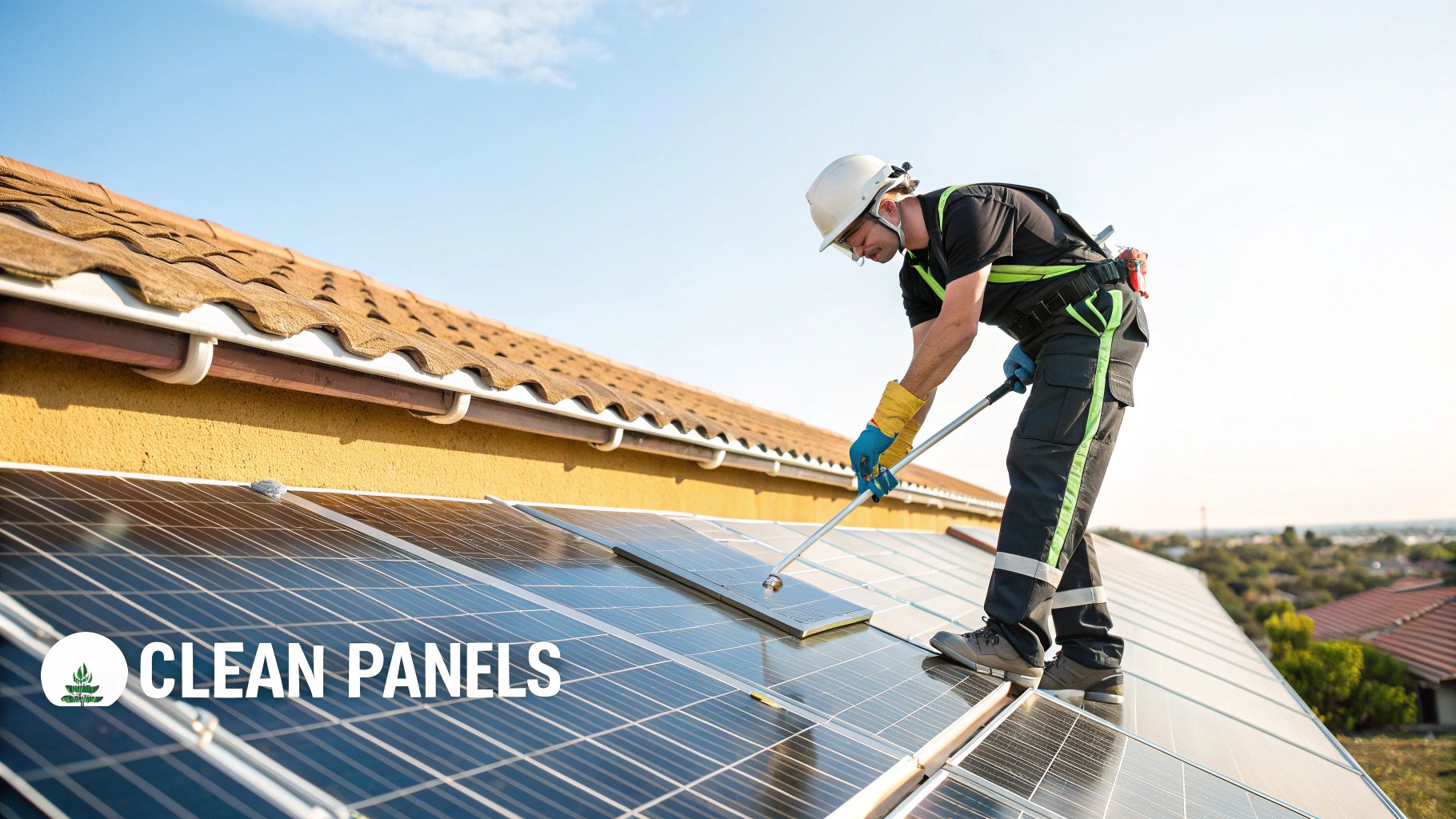
Como puede ver, el arco solar es completamente distinto en verano que en invierno. Un sistema diseñado sólo para el sol del verano puede tener un rendimiento muy inferior cuando llega el invierno. Una verdadera optimización significa planificar el rendimiento durante todo el año.
Sistemas instalados en el tejado o en el suelo
A veces, el mejor lugar para colocar los paneles no es el tejado. Por lo general, hay dos opciones principales, y cada una tiene sus pros y sus contras.
- Sistemas de techo: Esto es en lo que piensa la mayoría de la gente. Son fantásticas para ahorrar espacio, pero te quedas atascado con la pendiente existente de tu tejado, la orientación y cualquier problema de sombreado del que no puedas deshacerte.
- Sistemas instalados en el suelo: Si tienes espacio en el jardín, éste es el estándar de oro para la optimización. Puedes colocarlas en el lugar más soleado, libres de obstáculos, e inclinarlas hacia el centro. perfecto ángulo.
Este nivel de control es precisamente la razón por la que los grandes parques solares se construyen siempre sobre el terreno. Les permite controlar totalmente la posición, un factor crítico para aprovechar hasta el último vatio de energía del sol. De hecho 57% de capacidad solar mundial procede de sistemas instalados en el suelo. Muchos de ellos incluso utilizan tecnología de seguimiento para seguir al sol por el cielo, lo que aumenta su producción mucho más de lo que podría conseguir un panel fijo. Si quiere profundizar en las cifras, puede Más información sobre el mercado fotovoltaico mundial y ver hasta qué punto se ha impuesto este enfoque.
Dominar el ángulo y la orientación de los paneles
Una vez que hayas encontrado el lugar perfecto y libre de sombras, es hora de ponerse un poco más técnico. Hay que ajustar el ángulo y la orientación de los paneles para aprovechar hasta el último vatio.
Estamos hablando de dos ajustes clave: inclinación (el ángulo vertical) y azimut (la dirección de la brújula). Estos dos factores determinan la incidencia directa de la luz solar en los paneles, que es, sin duda, la principal variable en la cantidad de energía generada. Es un poco de ciencia, pero sorprendentemente sencilla.
Para cualquier persona en el hemisferio norte, la regla de oro es tener la cara de sus paneles verdadero sur. El ángulo de inclinación ideal, sin embargo, es un poco más específico: está ligado directamente a su latitud geográfica. Un punto de partida fantástico para cualquier sistema de inclinación fija es simplemente ajustar el ángulo para que coincida con su latitud. De este modo se obtiene una media sólida durante todo el año para captar la luz solar.
Adaptación a las estaciones
Si quieres ir un paso más allá, los ajustes estacionales pueden marcar una verdadera diferencia en tu rendimiento. El sol recorre una trayectoria más baja por el cielo en invierno y mucho más alta en verano. Para aprovecharlo, puedes ajustar la inclinación del panel para obtener un ángulo más directo del sol estacional.
Una estrategia común y eficaz sólo requiere dos pequeños ajustes al año:
- Inclinación invernal: Añadir 15 grados a su ángulo de latitud. Esta inclinación más pronunciada ayuda a los paneles a enfrentarse mejor al sol bajo del invierno.
- Inclinación de verano: Resta 15 grados de su ángulo de latitud. Un ángulo más plano es perfecto para captar los rayos del sol del verano.
Este sencillo ajuste estacional puede no parecer gran cosa, pero he visto que aumenta la producción anual de energía en un 5% a 8% en comparación con dejar los paneles en un mismo ángulo fijo todo el año. Es una forma sencilla de obtener una ganancia cuantificable.
El patrón oro: Seguimiento solar
Aunque los ajustes manuales son un buen empujón, los sistemas de seguimiento solar automatizados son la cima absoluta de la optimización. En lugar de estar bloqueados en una posición, estos sistemas utilizan motores y sensores para seguir el recorrido del sol por el cielo durante todo el día, como un girasol. Este movimiento constante mantiene los paneles perfectamente orientados al sol desde el amanecer hasta el anochecer.
Eche un vistazo a cómo funcionan estos soportes avanzados para maximizar la exposición al sol.
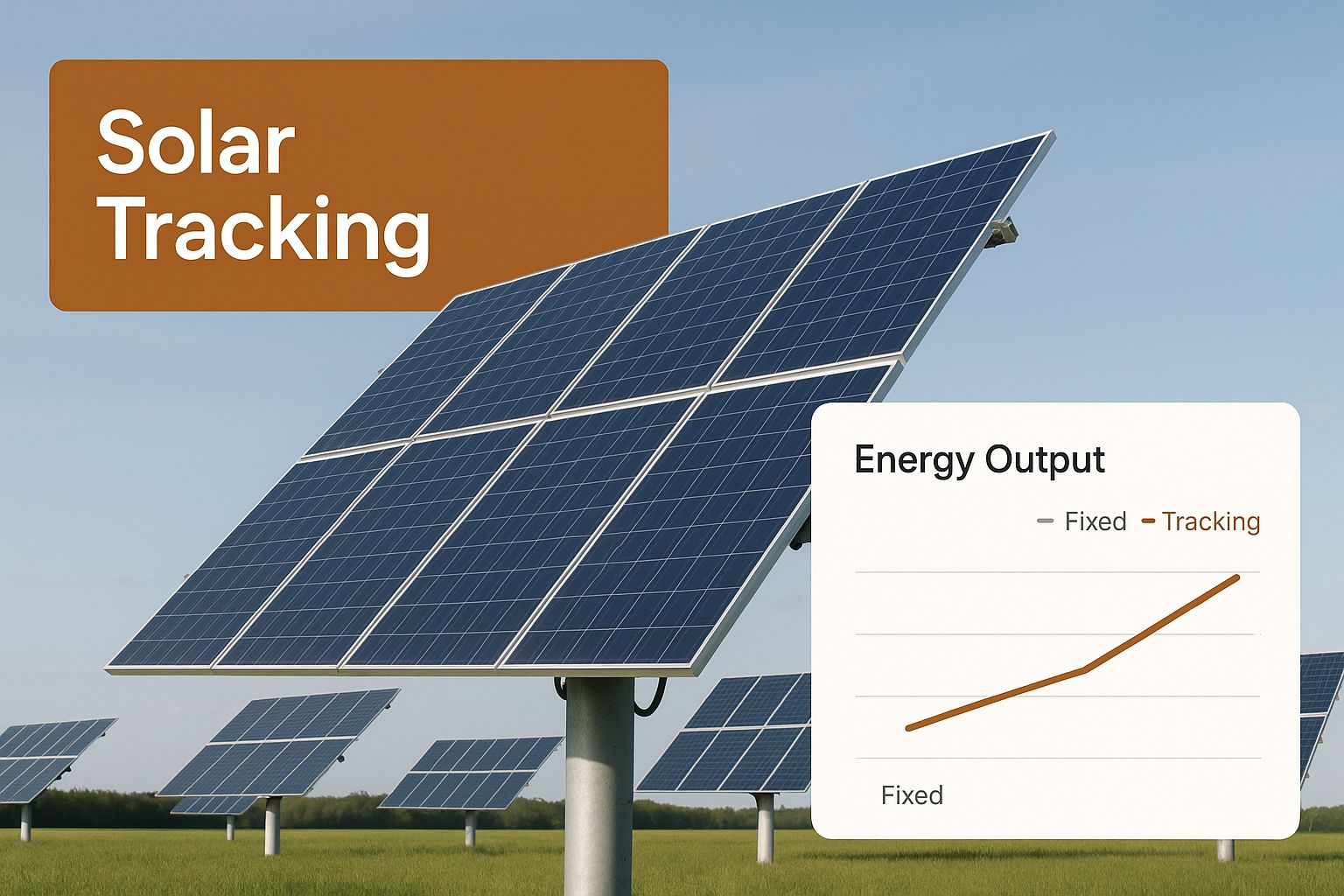
Al perseguir activamente al sol, estos sistemas pueden generar mucha más energía que una instalación fija.
Existen dos tipos principales de rastreadores. Seguidores de un eje siguen al sol de este a oeste, mientras rastreadores de doble eje hazlo y ajustarse a la altura estacional del sol. Un seguidor de doble eje puede aumentar la producción de energía en un increíble 40% sobre un sistema fijo.
¿El problema? Su mayor coste y complejidad mecánica suelen hacer que sean más adecuados para grandes proyectos comerciales instalados en el suelo, no para el tejado de una vivienda media. Para la mayoría de los propietarios, lo más práctico y rentable es mantener un ángulo fijo bien calculado o realizar sencillos ajustes estacionales.
Elegir los componentes adecuados del sistema
Puede tener los paneles mejor colocados y con el ángulo más perfecto del mundo, pero todo ese esfuerzo se va al traste si el hardware al que están conectados no es el adecuado. La verdadera optimización solar implica mirar más allá de la instalación sobre el tejado y analizar todo el sistema. Los componentes que elija, especialmente el inversor y el cableado, son los que determinan la cantidad de luz solar que realmente se convierte en energía que puede utilizar.
Me gusta utilizar una analogía: sus paneles solares son el motor, pero el inversor es la transmisión. No pondrías una transmisión torpe e ineficiente en un motor de alto rendimiento y esperarías grandes resultados, ¿verdad? La misma lógica se aplica a su instalación solar.
El gran debate sobre los inversores
La decisión más importante en cuanto a hardware es el inversor. Es el equipo que toma la corriente continua (CC) generada por los paneles y la convierte en corriente alterna (CA) para los electrodomésticos.
Durante años, la norma fue un inversor monofásico. Es un concepto sencillo: todos los paneles se conectan en serie (una "cadena") y su potencia combinada se envía a una caja central para su conversión. ¿Cuál es el problema? Esta configuración tiene un importante cuello de botella. Si un solo panel de la cadena se queda a la sombra o su producción disminuye por cualquier motivo, la producción de la cadena se ve afectada. cadena completa. Es como si un solo coche lento obligara a todo el carril de la autopista a arrastrarse detrás de él.
Por eso, la mayoría de las instalaciones modernas utilizan lo que se denomina electrónica de potencia a nivel de módulo (MLPE), como microinversores u optimizadores de potencia. Resuelven el problema del "coche lento".
- Microinversores: Piense en ellos como pequeños inversores individuales, uno conectado a la parte trasera de cada panel solar. Esto permite que cada panel funcione como su propia central eléctrica independiente. Un panel sombreado en una parte del tejado no afecta a los paneles soleados del resto.
- Optimizadores de potencia: Se trata de un enfoque un poco híbrido. Sigue habiendo un inversor central, pero cada panel tiene un pequeño "optimizador". Este dispositivo acondiciona la corriente continua de su panel específico antes de enviarla, aislando de hecho cualquier panel de bajo rendimiento para que no perjudique a todo el sistema.
Si su tejado tiene algo de sombra -incluso sólo de un tubo de ventilación o una chimenea durante una hora por la tarde-, los MLPE son una obviedad. Sí, el coste inicial puede ser un poco más alto, pero las ganancias de energía a largo plazo de la eliminación de las ralentizaciones de todo el sistema son más que vale la pena.
Elegir la electrónica a nivel de módulo es una de las formas más inteligentes de preparar su sistema para el futuro. Garantiza que los pequeños problemas inevitables no provoquen pérdidas de producción a gran escala, maximizando su cosecha de energía día tras día.
Por último, hablemos de algo que a menudo se pasa por alto: el cableado. Escatimar aquí utilizando cables de tamaño insuficiente crea resistencia, lo que conduce a algo llamado caída de tensión. Es una forma técnica de decir que se pierde una valiosa energía en el trayecto entre los paneles y el inversor. Un instalador cualificado calculará siempre el calibre adecuado de los cables para reducir al mínimo estas pérdidas y asegurarse de que cada vatio llega a su destino.
Seleccionar el hardware adecuado es un paso fundamental, y merece la pena ver lo que hay en el mercado. Puede explorar distintos productos de alta calidad productos solares y sus ventajas para hacerse una idea de lo que puede ser más adecuado para su hogar.
Ya ha realizado el duro trabajo de instalar y colocar correctamente sus paneles solares. Pero sacar el máximo provecho de su sistema no es un "configúrelo y olvídese", sino un proceso continuo. Con el paso de los meses, es inevitable que los paneles acumulen una capa de polvo, polen, excrementos de pájaros y suciedad en general. No se trata sólo de un problema estético; esa película actúa como un filtro, bloqueando la luz solar y reduciendo la producción de energía.
Le sorprenderá la diferencia que puede suponer un poco de suciedad. En zonas especialmente polvorientas o en lugares con largos periodos de sequía, esta suciedad puede reducir el rendimiento de su sistema en más de 1.000 horas. 20%. Una limpieza sencilla y periódica es una de las formas más fáciles de recuperar esa potencia perdida y asegurarse de que su inversión está dando sus frutos.
Una buena rutina de limpieza
El momento lo es todo. El mejor momento para lavar los paneles es por la mañana temprano o en un día nublado. Si intentas limpiarlos bajo el sol abrasador del mediodía, el agua se evaporará casi al instante, dejando tras de sí una nueva capa de residuos que puede ser tan mala como la suciedad que intentabas quitar.
Para la mayoría de los sistemas residenciales, basta con un planteamiento sencillo:
- Utilice herramientas sencillas: Un cepillo de cerdas suaves en una larga alargadera y una manguera normal de jardín suelen ser perfectos para este trabajo. Evita los detergentes fuertes o cualquier producto abrasivo que pueda rayar el cristal.
- Dar prioridad a la seguridad: Si sus paneles son de difícil acceso, no se arriesgue a subir al tejado sin el equipo de seguridad adecuado. Siempre es más inteligente -y a menudo más eficaz- llamar a un servicio de limpieza profesional. Disponen del equipo necesario para hacerlo con seguridad y rapidez.
Siempre le digo a la gente que considere sus paneles solares como el parabrisas de su coche. Cuanto más sucio esté, más difícil será ver a través de él. Un lavado rápido hace una gran diferencia en la visibilidad, y es exactamente el mismo principio para la producción de energía de su sistema.
¿Cuánta energía está perdiendo realmente?
La pérdida de rendimiento de los paneles sucios es tan gradual que es posible que ni siquiera se note en el día a día. Pero cuando se analizan las cifras a lo largo de todo un año, la pérdida acumulada puede ser realmente impactante. Este gráfico muestra en qué medida los distintos niveles de suciedad pueden reducir la eficiencia de su sistema.
Más allá de la limpieza: Su lista de mantenimiento
Aunque mantener limpios los cristales es crucial, un plan de mantenimiento realmente eficaz implica algo más. Recomiendo realizar una inspección visual rápida cada seis meses aproximadamente para detectar pequeños problemas antes de que se conviertan en problemas graves y costosos.
Esto es lo que hay que tener en cuenta:
- Busque daños físicos: Examine los paneles en busca de grietas, desconchones o signos de decoloración.
- Compruebe los herrajes de montaje: Revisa las estanterías. ¿Están bien apretados todos los tornillos y abrazaderas que sujetan los paneles? ¿Hay óxido o corrosión?
- Inspeccione el cableado: Compruebe si hay cables deshilachados, mordisqueados o expuestos a la intemperie. Asegúrese de que todas las conexiones estén bien apretadas y protegidas.
Este tipo de cuidado proactivo es la base del rendimiento a largo plazo de los paneles solares. Hay una razón por la que el mercado profesional de operación y mantenimiento (O&M) está en auge: se valoró en 1.000 millones de euros en 2007. 14.510 millones de dólares y va camino de casi duplicarse. Este crecimiento del sector pone de manifiesto una sencilla verdad: un mantenimiento constante es la clave para aprovechar al máximo la vida útil y la eficiencia de un sistema. Usted puede explore la previsión completa del mercado de O&M solar para ver lo importante que se ha vuelto esto.
Datos para ajustar el sistema
Si no puedes medirlo, no puedes mejorarlo. Es un viejo dicho, pero es una regla de oro cuando se trata de energía solar. Los sistemas de monitorización modernos le ofrecen un flujo constante de datos de rendimiento, lo que convierte optimización de paneles solares de un juego de adivinanzas a una ciencia precisa.
Estos datos, normalmente en una aplicación de su teléfono, son su línea directa para comprender exactamente cómo está funcionando su sistema en tiempo real. Es el informe de salud de su sistema, disponible 24 horas al día, 7 días a la semana.
Acostumbrarse a comprobar los datos de producción permite detectar pequeños contratiempos antes de que se conviertan en grandes quebraderos de cabeza. ¿Ha bajado de repente la producción? Puede tratarse de un problema con el inversor o incluso de un simple disyuntor activado.
Pero, ¿y si observas un descenso lento y gradual a lo largo de unas semanas? Eso es casi siempre un signo clásico de suciedad acumulada en los paneles. Conviene hacer una buena limpieza. Este tipo de monitorización proactiva le permite resolver los problemas de inmediato y evitar que su sistema rinda por debajo de lo esperado.
De las soluciones reactivas a los ajustes proactivos
He aquí un ejemplo real que veo a menudo. Abres tu aplicación de monitorización y te das cuenta de que la producción matinal de tu sistema ha bajado unos 15% en el último mes, incluso en días perfectamente soleados. ¿Por qué?
Este dato concreto le indica donde y cuando para mirar. Da un paseo por su propiedad y encuentra al culpable: la rama de un árbol ha crecido lo suficiente como para proyectar una nueva sombra sobre sus paneles por la mañana. Con esos datos, puede podar la rama y ver cómo sus cifras de producción vuelven a la normalidad.
Ese es el verdadero poder de la supervisión. Dejas de reaccionar ante una factura eléctrica sorprendentemente alta a final de mes y empiezas a encontrar y solucionar de forma proactiva la causa de cualquier ineficiencia. Si está interesado en conocer las diferentes configuraciones del sistema y las mejoras basadas en datos, eche un vistazo a varios ejemplos. soluciones de energía solar puede darte una idea de lo que es posible.
Cuando aprendes a leer la historia que cuentan tus datos, tomas el control total del rendimiento de tu sistema. Cada kilovatio-hora se contabiliza, lo que garantiza que siempre se está exprimiendo hasta la última gota de energía del sol.
El siguiente gráfico muestra un ejemplo perfecto de esto en acción: cómo los datos pueden mostrar claramente una caída del rendimiento y luego confirmar que su solución devolvió todo a la máxima eficiencia.
Preguntas frecuentes sobre la optimización de los paneles solares
Cuando te lanzas a sacar el máximo partido de tus paneles solares, siempre surgen algunas preguntas comunes. Es completamente normal. Vamos a repasar algunas de las cosas que la gente nos pregunta todo el tiempo para que pueda sentirse seguro acerca de su sistema.
¿Con qué frecuencia debo limpiar los paneles?
Sinceramente, depende totalmente de dónde viva. Si su casa está en una zona polvorienta, cerca de una obra o con mucho polen en primavera, es posible que tenga que limpiar los paneles cada seis meses para que funcionen lo mejor posible. Sin embargo, para la mayoría de los propietarios, una buena limpieza y una inspección rápida una vez al año es suficiente.
El mejor consejo que puedo darte es que dejes que tus datos te digan lo que tienes que hacer. No pierdas de vista tu aplicación de monitorización. Si observas una caída lenta y constante de la producción que no puedes achacar al clima, es una señal clásica de que tus paneles están sucios y necesitan un aclarado.
¿Merece la pena invertir en un sistema de seguimiento solar?
¿Para el típico sistema doméstico de tejado? Casi seguro que no. Es cierto que los seguidores pueden aumentar considerablemente la producción de energía. 25-40% más energía siguiendo al sol. Pero la realidad es que su coste y complejidad mecánica los hacen mucho más adecuados para grandes parques solares comerciales instalados en el suelo.
Para los propietarios de viviendas, el dinero más inteligente se gasta en fijar el ángulo de inclinación fijo perfecto para su tejado y asegurarse de que nada proyecta sombra sobre sus paneles. Es la forma más sencilla y fiable de maximizar la inversión.
Mi producción solar ha disminuido repentinamente. ¿Cuál es el problema?
Una caída repentina puede ser alarmante, pero que no cunda el pánico. Hay un sencillo proceso de solución de problemas que siempre recomiendo.
- Comprueba primero tu aplicación. Su sistema de monitorización a menudo arrojará un código de error que le indica exactamente lo que está ocurriendo.
- Mira tu caja de disyuntores. Vaya a su cuadro eléctrico principal y compruebe si se ha disparado el disyuntor conectado a su sistema solar. Es una solución común y fácil.
- Haz un rápido escaneo visual. Desde el suelo, mire hacia el tejado. Hay una rama grande, un frisbee rebelde o algún otro resto sobre un panel?
Si has probado todo eso y el problema no es evidente, es hora de llamar a un profesional. No te arriesgues a subir al tejado tú mismo.
En Energía radianteVivimos y respiramos estas cosas. Tenemos la experiencia para ayudarle a diseñar, instalar y mantener un sistema de energía solar que funciona a la perfección en los años venideros. Póngase en contacto con nosotros y empecemos a planificar tu camino hacia la independencia energética.

